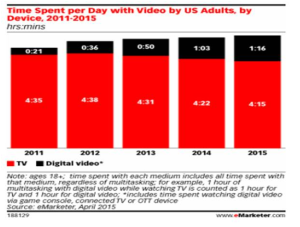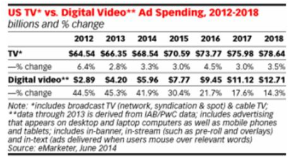Although many have predicted the demise of schedule-based network television (Linear TV), it still remains strong, with iconic events and shows continuing to draw big audiences. The 2015 NBA Finals received the highest TV ratings since ABC began broadcasting the series in 2002. The six-game series averaged a 13.9 overnight rating, making it the most watched Finals since Michael Jordan’s final championship with the Chicago Bulls in 1998.
The Rise of Digital Video
However while Linear TV has hung in there, the attention once given to the big screen is now being shared between two or even three different devices. Mobile phones, tablets and laptops now compete with the TV remote for viewers’ time. Additionally, there is considerable amount of activity happening on over-the-top (OTT) digital devices such as Apple TV, Google Chromecast, Roku, and even gaming consoles. The traditional boundaries between devices have blurred and TV/video content once confined to a single device can now be delivered across multiple platforms. This year, US Adults will spend an average of 1 hour, 16 minutes each day with video on digital devices. That is up from 21 minutes daily in 2011.
“The increase in overall screen time highlights the complexity of today’s media ecosystem,” said Paul Verna, senior analyst at eMarketer. “While so much debate has centered on a supposed tug-of-war between TV and digital video, the reality is that digital video is growing not at the expense of TV, but because video content is more popular than ever. We might spend less time watching on the main screen, but we’re no less interested in TV programming, and in fact, we seek out more of it every year.”
Digital video advertising in the US is increasing at a significant rate. Digital video spending is projected to increase 30.4% this year, while TV spending is projected to increase 3.0%. However, TV ad spending will still outpace digital video in dollar growth in 2015 according to eMarketer.
The Do’s and Don’ts of Video Advertising
TV content isn’t going away, it’s just going everywhere. Because of this, it no longer makes sense to consider linear viewing in isolation from other video platforms. The most successful video campaigns will be integrated across platforms, capitalizing on the strengths of each.
Television continues to be one of the most cost-effective ways to build awareness. The reach of TV makes it an effective medium for top-of-funnel awareness. Digital video can provide deeper engagement and precise targeting options making it suited for mid and lower funnel goals.
An eMarketer report, “50 Best Practices for Digital Video: Do’s and Don’ts for More Effective Advertising” offers some key suggestions on integrating TV and video ads:
- Use digital video to reinforce the larger TV campaign. Results from buys show that digital video can increase TV ad recall.
- Use TV for reach and digital video for frequency. TV typically raises a brand’s profile and creates impact. Digital video can then supplement with high frequency and much cheaper inventory bought through video networks or from a programmatic video buy.
What’s Next?
Well informed cross-platform video planning and buying is evolving. Key challenges still exist such as industry standard measurement to accommodate the integration of TV and digital video and the creation of compelling multi-screen content.
To consumers, video is video regardless of whether they are watching on a TV or a tablet. But for advertisers and agencies, planning that way will be challenging until the digital and linear sides come together.
Alan May
Just Media, Inc.


